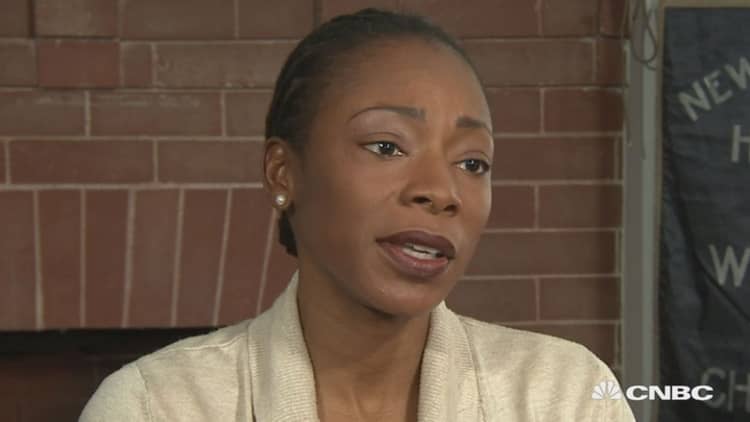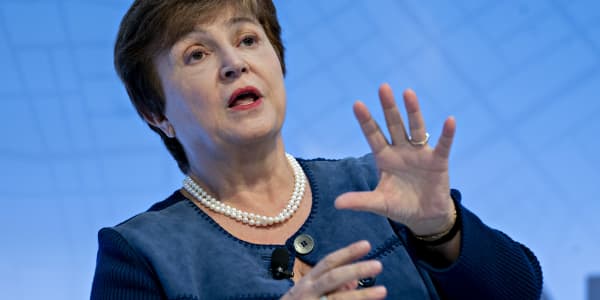


When Fantasia James-Hollins drops off 3-year old daughter Antalisa for day care at Boston's Dimock Health Center, she greets clinic staff members and teachers by name. For her, being at the clinic is like coming home.
"I've been off and on this campus since I was, basically, born. My mother used to come here," said the 29-year old mother of two.
With a history of hypertension and other health issues in her family, James-Hollins has made her kids' health care a priority.
"I can ask my doctor things that a lot of people may be embarrassed to ask their doctor," she said. "I just have so much a greater comfort being here, and I think that that does help you to be a step ahead of health and education."
History of Community Care
Providing access to care is a part of the Dimock Center's DNA. It began as the New England Hospital for Women and Children in 1862 — during the Civil War — and was one of the nation's first health-care facilities run by and for women. Its breakthrough nurse training program graduated America's first black nurse.
"With that history came a lot of responsibility to the community," said Dr. Myechia Minter-Jordan, Dimock's president and CEO.
Today, Dimock is a nonprofit community health center that serves 17,000 patients on a 9-acre campus in Roxbury, in the heart of Boston's African-American community, where almost 1 in 3 residents suffers with chronic health issues like asthma, high blood pressure and obesity.
"Health disparities in the black community come from a number of things; it comes from the poverty level, it comes from the education status, access to health care," Minter-Jordan said.
A big part of its primary-care model involves trying to reduce those barriers for their predominantly low-income patients.
"We not only have the delivery of health care but we have social services," she said. "If someone has diabetes and they cannot afford food, then that is something that we need to address in our model. Or, if someone has hypertension and cannot afford their medicine, we also have to address that."
Coordinated Care
There is a movement within the health industry to manage patients' health through greater coordinated care, through what's known as a medical home. Dimock's chief medical officer Dr. Holly Oh, said that kind of approach has been integral to what the clinic does.
"The total picture of health: that's what we're trying to get at," she said, "working to connect (patients) up to resources and services … that they might need to achieve total health and wellness."
Dimock gets 75 percent of its funding from state and federal sources. The health center has ramped up its fundraising to help expand programs and fund programs to assist its predominantly low-income patients.
The clinic has tried to create a seamless primary-care setting. Everything from dentistry and optometry to health screenings and a pharmacy are under one roof to make it more likely that patients will follow up on treatment.
It's finding success when it comes to preventive care. According to the most recent government data, in 2014 Dimock ranked well above the national average for health centers on almost a dozen federal health-quality measures.
The clinic outperformed when it came to issues that impact African-Americans most: prenatal care, cholesterol treatment, asthma management and cancer screenings; African-Americans are twice as likely as whites to die from asthma, prostate and cervical cancer.
One area in which Dimock lagged was in depression screening. So now the clinic has moved its mental health services into the primary-care setting, enabling doctors and counselors to work in side-by-side offices.
"When a family comes into our clinic, we're assessing the family," said Minter-Jordan, "(and) really trying to remove the stigma we often see in our community surrounding behavioral health by having it integrated seamlessly in our primary-care clinics."
It helps to have inherited a large campus where Dimock can offer a wide number of health and social services, but Oh says the key to making a difference for patients is grounded in something much more fundamental.
"Historically, in many different cultures ... there's a real distrust for the health system," Oh said. "What we work to do every single day at Dimock is to cultivate that trust, build relationships."
Patients like James-Hollins value that sense of trust.
"Dimock is a safe haven for a lot of people," she said. "I wouldn't even know Boston without Dimock."
Watch CNBC's "Power Lunch" each day this week to see the work being done to bridge America's divide.











